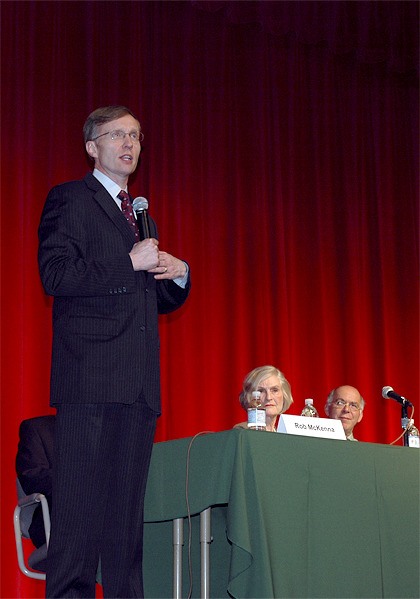For Mount Si High School senior Zac Pearlstein, it took an ounce of prevention — and a lock box — to stay on the straight and narrow while using powerful prescription drugs.
Prescribed Oxycontin after getting his tonsils removed, the senior faced regulation by his mother and awareness by his family while using the painkiller.
“Education and removing temptation really put me in a position where, even if I wanted to, I wouldn’t be able to obtain the drugs,” he said.
Pearlstein was among a panel of speakers pushing for early education and family communication at the Youth Prescription Drug Abuse Prevention Forum, held Wednesday, Feb. 24. Community members, parents and students filled the Mount Si auditorium to learn about prescription abuse, dubbed a rising, silent killer.
Washington State Attorney General Rob McKenna, who spoke at the meeting, said that abuse of legally obtainable drugs gets little media attention. But rising numbers of deaths worry him.
Because prescription drugs come in cute, innocuous bottles, and moms and dads use them, children may think they’re OK to use, too.
“Kids don’t get it,” McKenna said.
In 2005 and 2006, Washington state ranked sixth in the nation for the percentage of people 12 years old and older who abused prescription pain relievers, many of which can cause addiction and death. In 2008, the Washington State Poison Center received 89 reports of intentional exposure to prescription opiates by teens. Abuse was the most common motivation, followed by attempted suicide.
Instant relief
“Mount Si High School seems like the perfect place and venue for this event, because it is this age group that increasingly is most affected by the prescription drug epidemic,” said Andrew Heintz, a behavioral therapist at Snoqualmie Valley Hospital and a board member of the Snoqualmie Valley Hospital Foundation.
Heintz has been approached by increasing numbers of Mount Si High School students with issues surrounding prescription drugs.
He made youth prescription abuse prevention a personal priority and worked closely with the Science and Management of Addiction Foundation, or SAMA, in organizing last week’s forum.
Panel speaker Rosemary Orr-Rice, an anesthesiologist at Children’s Hospital and Medical Center in Seattle, became an advocate for the prevention of prescription drug abuse when she found her 24-year-old son dead from an oxycodone and cocaine overdose in 2006.
Like many parents who attended Wednesday’s forum, Orr-Rice said she was unaware about abuse’s growing, troubling role, until it was too late.
Easy access to drugs isn’t surprising, Orr-Rice said.
“Our society in general wants instant relief. We want things to be taken care of, and we want them to be taken care of now,” she said.
Snoqualmie Valley Hospital Emergency Room physician John Halper said most people find it unusual to leave a clinic or ER without a prescription. Even if a care provider doesn’t prescribe a drug, patients often ask for one, he said.
Lockdown
McKenna called for more education, as well as more tools for police, pharmacists and the public. He touted youth prevention summits, which teach children about ways to stop drug and alcohol abuse, as well as violence.
Prevention also starts in the home.
“If all you’ve done is say you don’t want them to do it, that’s not enough,” said Phoebe Terhaar, a prevention and interention specialist for Friends of Youth and the Puget Sound Educational District.
Terhaar shared strategies including monitoring and locking up prescription drugs, banning mood-altering substances in the home when youth are present, and signing a family pledge agreeing that drugs are not allowed.
At the end of the night, parents took home 40 lockboxes to prevent prescription drug abuse in their homes.



